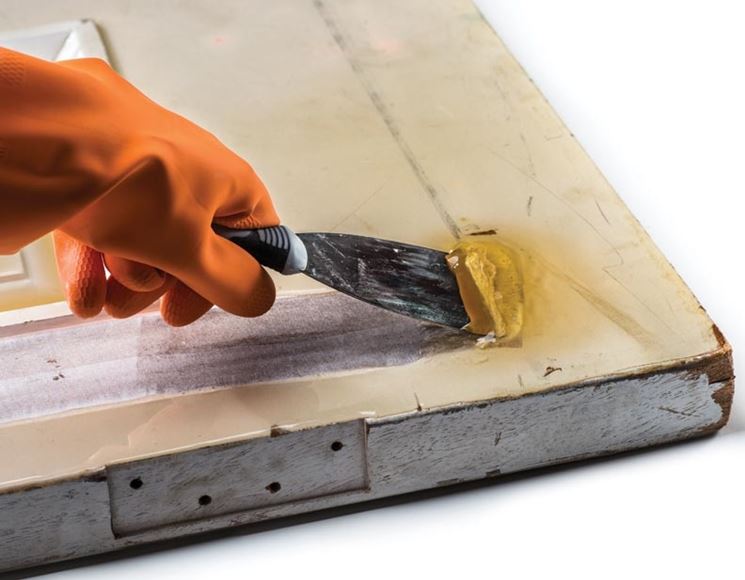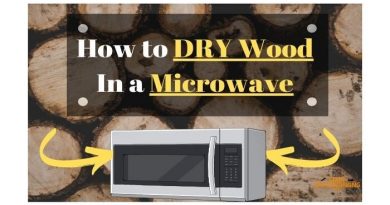How to Remove Paint from Wood
If you have an old furniture or you bought this old piece of wood furniture that seems to be a real hidden gem or you want to give a new look to your old dressers, doors, and other wooden items you need to know how to remove paint from wood!
There are multiple ways to remove paint from wood but the three main ways of removing paint from wood are: Sanding Method , Heat Gun Method and Chemical Stripper Method. There isn’t a simple way to get old paint off of wood, but some ways are safer than others.
There’s a lot you need to know about. Whether you’re looking to remove paint from wood furniture or from a door or wooden deck, there’s an option out there which will work well for you, so I will try to cover the proper one for you.
Before we go through the steps of removing the old paint from any sort of wood we must know:
- What tools do you need
- Restricted Practices
MATERIALS AND TOOLS TO REMOVE PAINT FROM WOOD
The following tools have long been proven to do the job right for me and also for you:
- Protective gloves
- Safety glasses
- Respirator
- Solvent based paint stripper
- Bucket
- Paintbrush
- Scraper
- Wire brush
- Rags
- Sandpaper
Remember that each one restoration,finishing or refinishing methods involve the use of hazardous chemicals.
Inhalation of fumes and skin contact with some of the chemicals can be really dangerous.
Special precautions measures are necessary to insure their safe use and to protect you. Damaged wood surfaces that contain lead-based paint represent a health threat to the people.
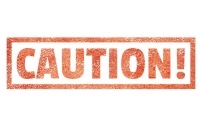
Keep these basic precautions in mind as you try to remove paint from wood:
- Always work in a well ventilated area(preferably outdoors or in a work area with an fan and all doors and windows open.
- If indoors, take numerous breaks in fresh outdoor air to reduce the effects of breathing solvent vapors.
- Do not try to smoke or go near any open flames when working with solvents,stripping liquids or vents, stripping liquids or finishes. Most of those chemicals are flammable.
- Handle all chemicals with care. Replace the caps immediately after pouring solvents and other finishing products. If chemicals are splashed on you, wash the area immediately with lots of water.
- Wear chemical resistant rubber gloves and safety goggles when working with solvents or stripping chemicals. Have many rags or other absorbent materials nearby to take in excess liquids.
- Get rid of oily rags properly,they may com-bust spontaneously. Keep oily rags submerged in water until you’ll eliminate them.
- Store solvent sand stripping chemicals in original containers faraway from heat sources and out of the reach of youngsters.
- Get rid of used solvents properly. The recommended disposal for any liquid hazardous waste is to take in all liquids with an absorbent ,such as cat litter,rags or paper towels.
These solvent-soaked materials are often burned during a safe incinerator, but never put the solvent container near or throw it in a fire-it will explode!

Restricted Practices when YOU Remove Paint from Wood
Damaged wood surfaces that contain lead-based paint represent a health threat to the people.
- Avoid Extensive Dry Scraping or Sanding.
Doing excessive sanding or scarping on wood will generate a lot of dust, paint chips and a lot of debrief.
- Use Wet Methods or Limited Dry Scraping and Sanding instead.
You should mist the surface before scraping and sanding the wood and continue to do this while working.
Especially dry scraping or sanding of some small areas (like around light switches or outlets) may be done if flat surfaces below these areas are covered with protective sheeting.
- Don’t Use Paint Strippers that contains Methylene Chloride when you try to remove paint from wood.
Many paint strippers may be dangerous but strippers containing methylene chloride shouldn’t be used because this chemical is extremely toxic and is known to cause cancer!
- Use Other Chemical Strippers with Appropriate Precautions
Other chemical strippers that don’t contain methylene chloride are safer to use, as long as the precautions present on the container are followed. Take extra precautions to mask areas near stripping.
- Don’t Use Open Flame/High Heat Removal of Paint from Wood.
You shouldn’t use an open flame torch or high temperature heat gun (above 1000 degrees F) to get rid of paint from wood.
It produces toxic gases that a HEPA dust canister on a respirator cannot filter out on its own.It is possible to burn down the house.
- Use a Heat Gun on Low Setting Instead.
A heat gun should be set (below 1000 degrees F) and be used with caution.
It is recommended for small areas only, such as the edge of a door, the top of a window stool, or the friction surface of a window jamb.
- Avoid Using Power Sanders or Grinders Without HEPA Vacuum Attachment.
These machines create tons of dust which will contaminate a building and therefore the ground around a building endangering workers, neighbors, and occupants.
- Use Controlled Sanding or Grinding With HEPA Vacuum Attachment.
If the sanding or grinding machines are “shrouded,” which means they are surrounded with a filter that prevents dust from flying out around and also have attached a HEPA vacuum, they can be used.
Sometimes some dust may still get out, so workers near the machine should wear half-mask respirators rated by N.I.O.S.H as N100 (or HEPA) at a minimum.
Does the paint you’re removing from wood contain lead?
Test Paint for Concentration of Lead
Before you begin to remove paint from wood, you need to test the paint for lead. Most paints manufactured before 1960 contain lead so if you’re stripping something older than that it’s necessary to check.
Lead paint is usually not dangerous in its dried state on the walls, but it becomes a hazard when its scraped off and ingested, or inhaled as dust. Lead is a highly toxic metal which will cause a variety of health and neurological problems.
You can buy a lead testing kit from 3M LeadCheck Swabs, 8-Pack and also you can read more about how to deal with it from British Coatings Federation: “Old Lead Painted Surfaces – A Guide on Repainting and Removal for DIY and Professional Painters and Decorators”.
The test is simple as squeezing the 2 ends of the lead tester, shaking it to combine the liquids, then rubbing that liquid onto all of the layers of paint.
Using Sanding Method to Remove Paint from Wood
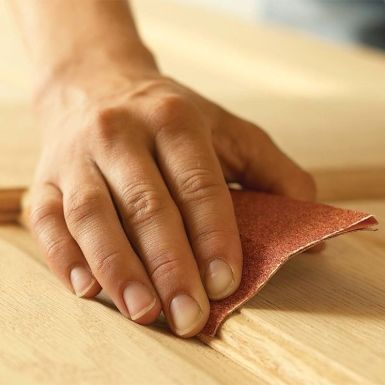
Protect yourself.
Wear safety goggles and a mask to shield yourself from paint and wood dust as you sand, despite the sanding method you utilize.
Before you start the job, remove all the hardware(screws,doorknobs, brackets etc) from the wood.
If you cannot remove some parts that are not made from wood, you should cover them with protective tape.
Get the proper sandpapers
One of the simplest ways to remove paint from wood is to use sandpaper.
Sandpaper is simple to get in any hardware store or many other common stores, making this one among the simplest options to use if you don’t have any specialist equipment available.
Make certain that you’ve got two differing types of sandpaper on hand:
- rough sandpaper( to remove the undesired paint) or remove the majority of the paint;
- smoother sandpaper to tidy the last traces and smooth off the wood underneath.
Try to sand the paint off by hand every time you have the opportunity.
When you remove paint from a crack or stripping it from a small or delicate wood object, you should always first sand the paint off by hand.
- Mechanical sanders apply a lot of force on the surface and can damage delicate pieces. Also, they are definitely difficult to use on small, confined spaces.
- Use coarse, open-coat sandpaper since other types may clog with paint and wood dust too quickly.
- Sand with the grain of the wood instead of against it.
- Decrease to a medium grit paper once you can see the grain of the wood peeking through the paint.
- Decrease to a fine grit when small bits of paint are all that remain.
I bought a few 220 grit sandpaper and really worked on getting the wood grain to be even and to get rid of any “water” stains that the stripper and mineral spirits had left.
For stripping old furniture I recommend using a triangular finish sander or an oscillating tool with a pointed sanding attachment. The advantage using these is that they get into the corners where a rectangular sander can’t reach.
You may have a larger job to do!
In the case of larger areas of painted wood, including large pieces of wood furniture, large wooden chests, or wood trim, consider a mechanical sander to save lots of time.
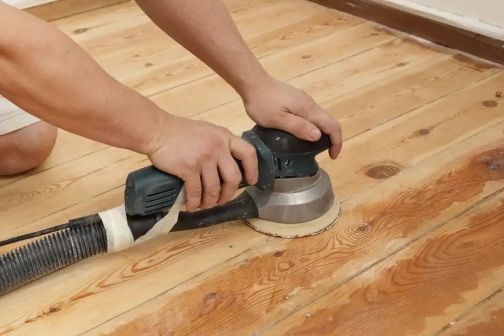
When picking a mechanical sander consider the following options: Disk, Belt and Drum Sanders.
Make sure you always sand following the grain of wood instead of against , so you’ll not scratch the wood surface and harm to the wood.
Once the majority of the paint has been sanded off then switch to fine grain sandpaper to remove the few small specks left.
Wash the wood after sanding is complete.
If you’re planning to repaint or varnish the wooden surface, wipe down the wood with a cloth dipped in paint solvent to get rid of all traces of wood dust or leftover paint particles.
Once you’ve wiped it down like this, you’re able to repaint or varnish the wooden surface! If there’s wood dust on the ground , sweep it away.
Using Chemical Stripper Method to Remove Paint from Wood
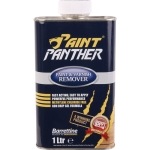
Nearly all kinds of finishes are often removed with paint and polish removers.
These are expensive,however,and often require a water rinse which can end in some grain raising of the wood surface.
A more economical approach that works well on shellac and lacquer finishes is to organize your own stripper with ethyl alcohol and lacquer thinner.
There also are commercially-prepared furniture refinishing solutions, such as Formby’s Refinisher, Hopes Refinisher* and others, which are a mix of three or 4 strong solvents.
Choose the right type of paint stripper.
Chemical strippers are available in a variety of strengths, but you utilize all of them in basically a similar way.
Apply a good amount on the stripper with an old paint brush, let it work, then scrape off the softened and bubbling paint with a paint scraper.
We highly recommend Paint Panther Paint and Varnish Remover. One among the most effective wood strippers on the marketplace for day to day paint and polish removal.
It’s great for removing paint and polish from wood. It’s an interesting product, highly effective and incredibly fast-acting, removing as many as six layers in only five minutes!
Paint strippers and polish removers are usually available in sample or small tin sizes of between 250ml to 500ml.
Our recommendation is to shop for a sample or small tin and to trial the effectiveness of a product before committing to purchasing the amount of wood stripper needed for the project. This way you will save time and money in the long-term.
It’s messy work, and you’ve got to protect your skin and eyes from the stripper, which is extremely caustic and may burn.
Strippers rarely remove all of the paint, and you always need to sand off what remains.
You’ll make the sanding easier by washing the wood with lacquer thinner to get rid of paint residue before you sand.
Know how to apply the chemical stripper the right way!
Another easy way to apply chemical paint stripper is to pour it into a sprig bottle and mist it onto the surface from about 4 inches faraway from the wood.
But if you are using one of the liquid solvent removers ( like alcohol, lacquer thinner or refinishing solutions) here is what you can do:
- Brush stripper liberally onto a little area of the wood surface.
- Work stripper into the old finish by rubbing with wire wool , using grade 00 on hardwoods and grade 000 on soft woods.
- Using a rag wipe wipe down the wood surface before the stripper dries.
- Keep repeating the step 1 to 3 until the old finish is clear.
Give the chemical time to work
Leave the paint for about half-hour after spraying, then start to scrape the weakened paint faraway from the wood with a metal paint scraper.
If you’ve applied the chemical paint stripper correctly, it should be weak enough to scrape off the wood relatively easily!
To prevent potentially fumes from building up keep the windows and doors open.
How to remove paint from wood without chemicals?
I was stripping a piece of furniture the other day and wondered, how could I remove paint from wood without chemicals?
So I did some research and I find out so many ways to get the job done in a safe manner without chemicals:
- Soy-Based Gel Paint Removers
- Paint Remover with Vinegar
- Baking Soda and Boiling Water
- Citrus-Based Paint Removers
Using Heat Gun Method to Remove Paint from Wood
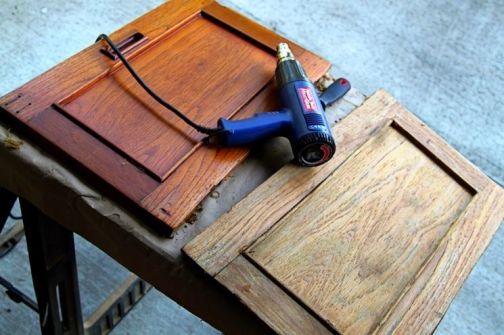
Using a heat gun to get rid of paint from wood may be a much easier option than using sandpaper, but far more dangerous if you don’t know what you’re doing.
For this method, you’re going to need a heat gun, also as a variety of safety equipment.
When using a heat gun to remove paint from wood, always wear goggles and a mask , also as ensuring that there’s water easily at hand.
This system is comparable to the burning off method but fire risks are less because the temperature is lower.
This tool is meant to melt and blister oil-based paints and varnishes. After you finish then scraped away the paint with a stripping knife or scraper.
How to use heat gun?
Switch the heat gun on, and position it 6 to 8 inches (15 to 20 cm) away from the painted wood you’re trying to remove paint from.
Slowly move the heat gun across the surface without leaving in one place for too long.
This will weaken the paint,and once you’ve weakened the paint, it’ll start to wrinkle a little which is the sign that it can be scraped up and lifted away.
As that happens, scrape the paint upwards with a metal paint scraper or with a broad paint scraper, lifting it from the wood.
Focus on one small area at a time, carefully scraping off the paint while it’s still warm.
Conclusion
The methods described above are some of the most effective ways to remove paint from wood.
Using any of the methods mentioned above you should be able to remove paint wood with ease and confidence keeping your wooden furniture and doors looking fresh and new and simplifying the process of repainting wooden areas effectively.
RECOMMENDED READING:

